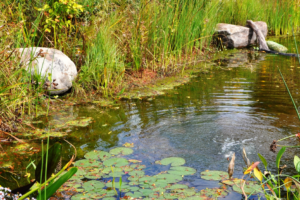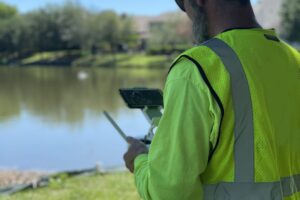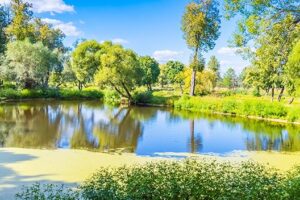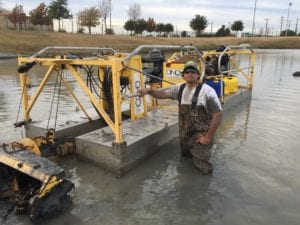
The concept of dredging is simple, but the execution of a dredging project is more complex than it looks on the surface. This condensed, practical guide to dredging (in the form of a case study) will help you when considering, planning and executing a dredging project of your own. The examples used in this guide are taken from a recent project PondMedics, Inc. conducted on two irrigation/storm water retention ponds at a world-renown soccer complex in a northern suburb of Dallas.
QUESTION 1: How do I know I need to dredge? “Everything is underwater, hidden from the visible eye, so how do I determine if I need to dredge?” If evidence is already surfacing such as silt “islands”, sand bars or debris collection, you already know you need to dredge. But, what if sediment is accumulating below the surface and signs are not as obvious? Then, next you need to perform a pond or lake survey.
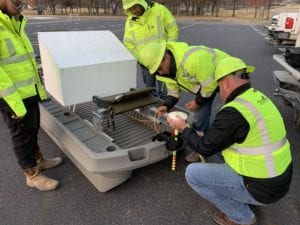
Larger bodies of water require larger survey boats outfitted with the survey-grade sampling tools.
QUESTION 2: What type of pond or lake survey do I need? Two types are most important – current water depth (bathymetry) and sediment thickness/depth (sub-bottom profiling). The instruments used to collect the data must be “survey-grade” tools so the data collected is precise and reliable. Recreational-grade sonars and GPS’s do not provide accurate data by which to measure, plan or execute a dredging project.
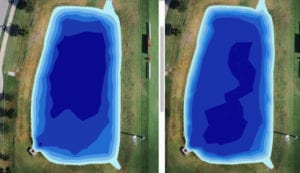
Pre-dredge bathymetric survey (current water depth measured at full pool) in 3D, shaded format. Each shade represents a 1 ft contour.
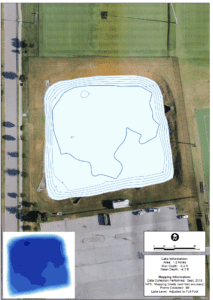
Pre-dredge bathymetric survey in a 2D view. Each contour line represents a one foot change in water depth.
QUESTION 3: How do we use the survey to plan the dredging? Our surveys identify the areas of sediment accumulation and calculate the volume of sediment contained in the pond or lake in the form of cubic yards. These pieces of information allow us to accurately quote the dredging project and determine equipment staging and de-watering logistics.
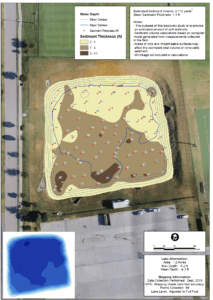
Each map identifies the location of the sediment deposits and quantifies how much sediment has accumulated in the ponds.
QUESTION 4: What is happening during the dredging process? In short, a hydraulic dredge stirs up the sediment on the bottom of the pond, mixing sediment with water so it’s easily pumped out of the pond or lake for dewatering and disposal. Mechanical dredging is different from hydraulic dredging. Mechanical dredging utilizes conventional earth-moving equipment to remove sediment. It typically requires partial or full draining of a pond or lake and can be much more invasive than hydraulic dredging.
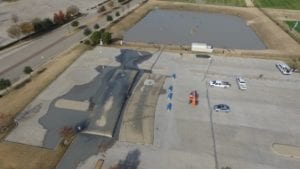
Each map identifies the location of the sediment deposits and quantifies how much sediment has accumulated in the ponds.
QUESTION 5: All the work is done underwater. How do I have confidence the project is competed according to the contract agreement? This is where pre-dredging and post-dredging surveys are critical. If you did not perform a pre-dredge survey, you could not compare it to the post-dredge survey and verify the work was done. With pre and post-dredge surveys, you can have confidence you are getting what you paid for.
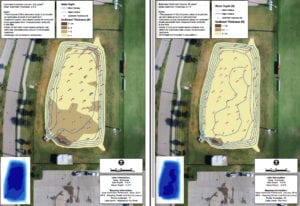
Pond #1 Before/After | Left: pre-dredge sediment survey. Right: post-dredge sediment survey
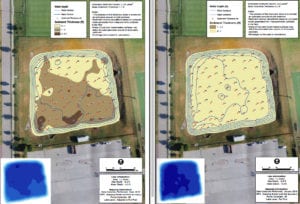
Pond #2 Before/After | Left: pre-dredge sediment survey. Right: post-dredge sediment survey.
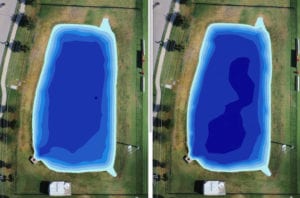
Pond #1 Before/After | Left: pre-dredge bathymetric (water depth) survey. Right: post-dredge bathymetric survey
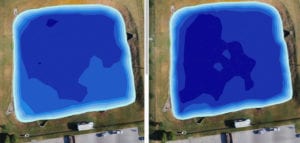
Pond #2 Before/After | Left: pre-dredge bathymetric (water depth) survey. Right: post-dredge bathymetric survey
Question 6: What happens to all the material after it’s pumped out? A dredging contractor actually considers this question within the first 60 seconds of quoting a dredging project. “Where is it going to go?” It’s one of the most important questions that can be asked on a dredging project. The answer can vary widely, based on the opportunities and challenges unique to your project. So, although this is the last item, logistically, of a dredging project, it’s the first question that’s asked when planning and quoting a dredging project.

